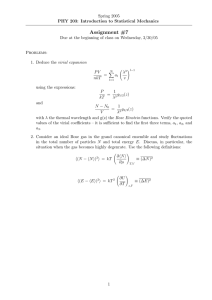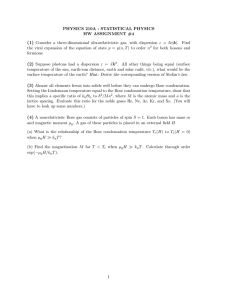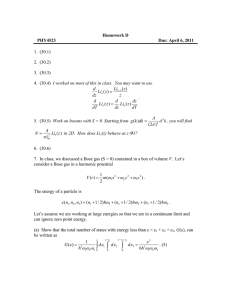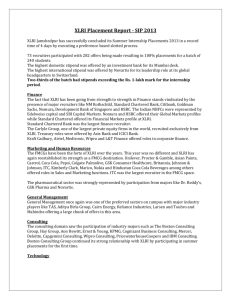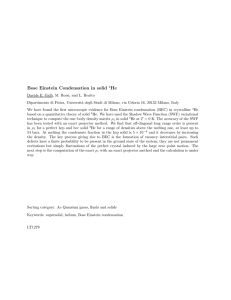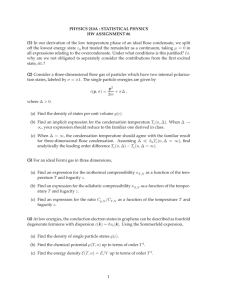Operations Management: Waiting Lines, Service, Performance
advertisement
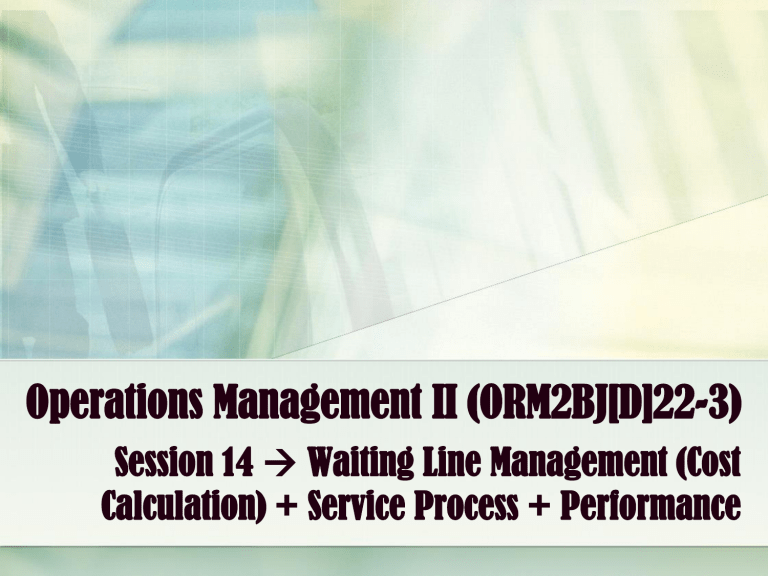
Operations Management II (ORM2BJ[D]22-3) Session 14 → Waiting Line Management (Cost Calculation) + Service Process + Performance Cost Optimization in Waiting Line ◼ ◼ ◼ ◼ ◼ ◼ Infinite population ◼ Total cost = Ls × Cost of waiting per customer + S × Cost of each server Finite population ◼ Total cost = N − J × Cost of waiting per customer + S × Cost of each server Textbook – Example 6 (Page 800) Textbook – Example 11 (Page 810) Textbook – Problem 10.e (Page 817) Textbook – Problem 11.b (Page 818) Dipankar Bose - XLRI Average Number Down – Concept – Not for Quiz/End-term ◼ ◼ ◼ ◼ ◼ ◼ ◼ ◼ ◼ Average number down = N – J = N – NF(1 – X) = N[1 – F + XF] Average Downtime per customer = T(1 – F)/XF + T = T[1 – F + XF]/XF T/X = T + U Total Cycle Time= T + U + T(1 – F)/XF = [1/F]T/X = T/XF Total downtime per time unit = (Average downtime per customer × N)/Total Cycle Time = Average Number Down Dipankar Bose - XLRI Topic: Service Process Dipankar Bose - XLRI Types of Services – Chase (1978) ◼ ◼ ◼ ◼ Pure service – High contact ◼ Health centers/ Hotels/ Public transports/ Restaurants/ Schools/ Personal services Mixed service ◼ Branch offices of banks, computer companies, post offices Quasi-manufacturing – Low contact ◼ Head offices of banks, computer companies, post offices Service ≠ Service Industries – Bitner et al (2000) ◼ Customer service/ Service as value added/ Service offerings as the product Dipankar Bose - XLRI Service Sector – Common Characteristics ◼ ◼ Inseparability ◼ Services are created and consumed at the same time ◼ Services cannot be “fully” inventoried ◼ Exception → knowledge services ◼ Demand fluctuations cannot be solved by inventory ◼ Quality control cannot be achieved before consumption Heterogeneity ◼ From the client’s perspective ◼ There is a wide variation in service offerings ◼ Personalization of services ◼ Increases their heterogeneous nature ◼ Perceived service quality varies from one client to next Dipankar Bose - XLRI Service Sector – Common Characteristics – Continued ◼ ◼ Intangibility ◼ Services are ideas/concepts that are part of a process ◼ The client typically relies on the service providers’ reputation ◼ Regulations and governance are means to assuring some acceptable level of quality-of-service Perishability ◼ Any service capacity that goes unused is perished ◼ Services cannot be stored → When not used to maximum capacity service provider lose opportunities ◼ Service capability estimation and planning are key aspects for service management Dipankar Bose - XLRI Service Process Matrix – Schmenner (1986) Dipankar Bose - XLRI Dipankar Bose - XLRI Service Design – Service Blueprint Customer Arrive and actions Fill out deposit ticket. Line of information Contact person(s) Wait in line if necessary Hand teller cash or check and deposit ticket Receive receipt Teller greets customer. Teller checks cash or check and enters amount. Teller prints out receipt and hands to customer Line of visibility Backstage contacts Line of internal interaction Support Lunch and rest breaks are managed based on waiting lines. Leave Account is automatically updated. Cash is counted and reconciled with transactions Schedules Employees are set are paid weekly Dipankar Bose - XLRI Issues with Service Operations – Sasser (1976) – NOT for Quiz/End-term ◼ ◼ ◼ ◼ ◼ ◼ Increasing wrong kind of capacity Not increasing all around capacity Not considering competitive reaction Undercutting one’s own service How to manage demand in service ◼ Pricing/ Developing non-peak demand/ Developing complementary services/ Creating reservation system How to control supply in service ◼ Use part time employees/ Maximize efficiency/ Increase consumer participation/ Share capacity/ Invest in expansion ante Dipankar Bose - XLRI Service Operations – History – NOT for Quiz/End-term Time Period Big ideas: Theory and Practice Application of scientific management to services – Leffingwell, Gilbreth, Barnes 1900–1950s Walt Disney: industrialized fantasy Holiday Inns: consistency in multi-site services – Kemmons Wilson McDonald’s: production-line approach to services – Standard, simple, automated 1960s Service economy and operations in health care – Layout, location, capacity Industrialization of services – Shostack/ Match supply and demand in services 1970s The customer contact model – Chase/ Data envelopment analysis – Charnes et al Classify services to gain marketing and operational insights – Schmenner Gap model of service quality and SERVQUAL – Parasuraman et al 1980s Strategic service vision – Heskett/ Unconditional service guarantee Psychology of queues – Maister, Larson/ Yield management Service profit chain – Service recovery Using poka-yoke, or fail-safe, methods to prevent human errors in service systems 1990s Globalization of information-intensive services Emergence of experience economy Using behavioral science in service operations Managing operations in information-intensive services 2000s Information technology in services and e-services Global business process outsourcing/ Service design Dipankar Bose - XLRI Topic: Performance Measurement – Overall Equipment Effectiveness (OEE) Dipankar Bose - XLRI Overall Equipment Effectiveness (OEE) ◼ ◼ ◼ OEE = Availability x Performance x Quality Total Effective Equipment Performance (TEEP) = Loading x OEE ◼ Loading = Loading Time / Total Time Six Big Losses ◼ Breakdowns ◼ Setup and Adjustments ◼ Small Stops ◼ Reduced Speed ◼ Startup Rejects ◼ Production Rejects Dipankar Bose - XLRI Overall Equipment Effectiveness (OEE) – Calculations – Internet Resource Dipankar Bose - XLRI Overall Equipment Effectiveness (OEE) – Example Item Data Shift Length 8 hours = 480 min. Short Breaks 2 @ 15 min. = 30 min. Meal Break 1 @ 30 min. = 30 min. Preventive Maintenance 25 minutes ◼ Downtime 35 minutes Ideal Run Rate 60 pieces per minute Total Pieces 15,000 pieces Reject Pieces 500 pieces Calculate OEE and TEEP Dipankar Bose - XLRI Internet Resource – OEE Calculator Dipankar Bose - XLRI ORM2BJ[D]22-3 – Quiz 4 Details ◼ Syllabus (Sessions 12-14) ◼ Comment type (5-10 marks) ◼ Numerical (10-15 marks) ◼ Date – March 06, 2023 Time– 1 hour 15 minutes (9:15 AM to 10:30 AM) ◼ ◼ Important instructions ◼ Mode – Pen and Paper ◼ Notes/Photocopies/Print outs allowed ◼ Calculator allowed ◼ Laptop NOT allowed ◼ Textbook MUST (Stevenson) Dipankar Bose - XLRI
